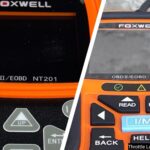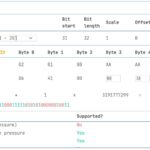The On-Board Diagnostics version 2 (OBD2) standard is a cornerstone of modern vehicle diagnostics. This comprehensive guide delves into the intricacies of the Obd2 Spec, covering its history, functionality, future trends, and practical applications.
Understanding the OBD2 Spec: Core Components
The obd2 spec defines a standardized system for accessing vehicle diagnostic data. Key elements include:
- OBD2 Connector: A standardized 16-pin connector, typically located near the steering wheel, providing access to the vehicle’s communication network. The obd2 spec defines the pinout for various communication protocols.
- Communication Protocols: While initially utilizing various protocols, the obd2 spec now mandates Controller Area Network (CAN) as the primary communication method for most vehicles. ISO 15765-4 specifies the use of CAN for OBD2, defining baud rates, CAN identifiers, and message formatting.
- Diagnostic Trouble Codes (DTCs): Standardized codes that indicate specific malfunctions within the vehicle’s systems. The obd2 spec outlines the structure and meaning of these codes, enabling technicians to quickly diagnose issues.
- Parameter IDs (PIDs): Codes used to request specific data points from the vehicle’s various electronic control units (ECUs). The obd2 spec defines a wide range of PIDs for accessing real-time data such as vehicle speed, engine RPM, and fuel level.
- Modes of Operation: The obd2 spec defines ten modes, each providing access to different types of diagnostic information. Mode $01 displays current data, while other modes provide access to freeze frame data, DTCs, and other diagnostic functions.
Evolution of the OBD2 Spec
Originating in California for emissions control, the obd2 spec has been adopted globally. Key milestones include:
- 1996: Mandatory implementation in the USA for cars and light trucks.
- 2001: Adoption in the EU for gasoline cars.
- 2008: The obd2 spec mandated the use of ISO 15765-4 (CAN) as the primary communication protocol in the USA.
The Future of OBD2 and the OBD2 Spec
The obd2 spec continues to evolve, driven by advancements in vehicle technology:
- OBD3 and Telematics: Potential future iterations of the obd2 spec may incorporate wireless communication for remote diagnostics and emissions testing.
- Security Concerns: The increasing reliance on vehicle data raises concerns about cybersecurity. Future versions of the obd2 spec will likely address these challenges with enhanced security measures.
- Electric Vehicles (EVs): The obd2 spec was not initially designed for EVs. Current EVs often utilize proprietary diagnostic systems, requiring adaptation of the obd2 spec or the development of new standards.
Practical Applications of the OBD2 Spec
The obd2 spec enables a wide range of applications:
- Vehicle Diagnostics: Technicians utilize OBD2 scanners to retrieve DTCs and real-time data, facilitating efficient troubleshooting and repair.
- Data Logging: Devices leveraging the obd2 spec can record vehicle data for performance monitoring, fleet management, and insurance purposes.
- Predictive Maintenance: Analyzing OBD2 data can help predict potential vehicle failures, allowing for proactive maintenance and reduced downtime.
Decoding OBD2 Data: A Deeper Dive into the OBD2 Spec
Understanding the structure of OBD2 messages is crucial for interpreting vehicle data:
- OBD2 Message Format: Messages consist of a CAN identifier, a data length indicator (PCI), and data bytes containing the mode, PID, and the requested data.
- Data Interpretation: The obd2 spec provides scaling information for converting raw data values into meaningful physical units (e.g., km/h, degrees Celsius). Tools like DBC files facilitate this decoding process.
Conclusion
The obd2 spec provides a foundational framework for vehicle diagnostics and data access. As vehicle technology continues to advance, the obd2 spec will undoubtedly undergo further development to meet the evolving needs of the automotive industry. Understanding the core principles of the obd2 spec is essential for anyone working with vehicle diagnostics, data logging, or telematics systems.

